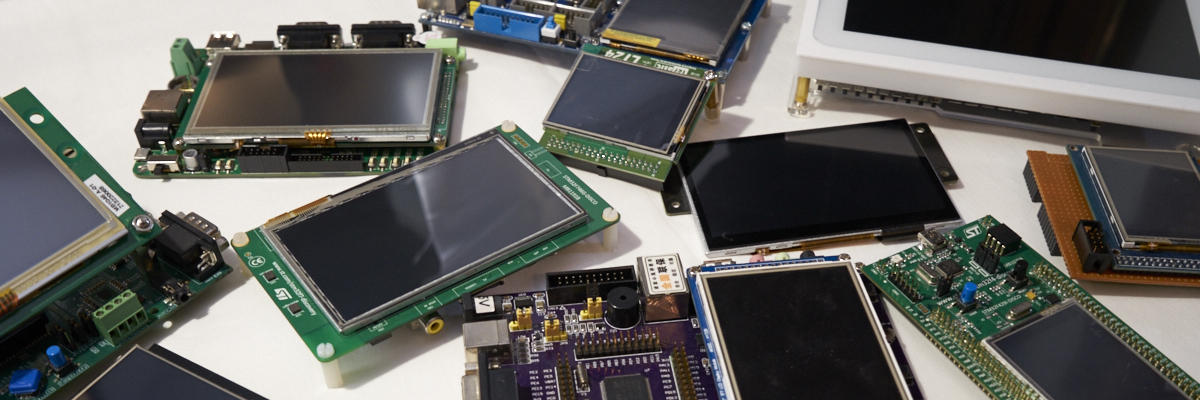-
Posts
2,659 -
Joined
-
Last visited
-
Days Won
2
Content Type
Forums
Store
Downloads
Blogs
Everything posted by Joel Bodenmann
-
Did you ensure that you actually have enough memory left to open that many images at once? You might want to check the return value of gdispImageOpenFile() (or equivalent of the Imagebox). The value returned is of the type gdispImageError, it will tell you what caused the failure. The possible values are documented in /src/gdisp/gdisp_image.h. The same applies to gdispImageDraw() (or equivalent of the Imagebox). Just to ensure that I understand this the right way: You are able to display all images - just not at the same time?
-
Most likely the fault is caused by the GFILE_MAX_GFILES setting in the configuration file which is too low. Can you please try increasing that value and retry? The µGFX-Studio is supposed to calculate the correct number required, however, there might be a bug. In case of you need to access files that the µGFX-Studio doesn't know, you can add those in the GFILE tab in the Project Settings.
-
Okay... I am having a hard time following you on what is working know and what questions you have. If you have questions that are not related to the first post in this topic, please don't hesitate to create a new topic. It is very important to us to keep the forum clean, structured & well organized. It makes it a lot easier for us to reply to your questions and it makes it a lot easier for other people to find answers using the forum search.
-
It is a file that contains library-internal specific stuff. It can happen that we modify the file contents. Think of the simple example where we add a new module to the µGFX library: We'd have to modify the gfx_mk.c file. The goal is that you can simply replace the µGFX library directory without any modifications to upgrade to a newer version. When copying library files like gfx_mk.c to your own project you prevent that from working. We strongly advice against doing that. Glad to hear that you got everything working. We appreciate any kind of guide, tutorial, example project or similar. This can be helpful to many people. They are not useless. They are used to calculate the timings during compile-time which vary from display panel to display panel. Of course the users can do the calculations manually and enter the result instead but these calculations happen during compile time and therefore have zero run-time impact. The parameters supplied to those macros are the more natural information than supplying the result calculated by hand. In fact, the parameters passed to those macros is what you will find 1:1 in the display panel's datasheet.
-
Glad to hear that you managed to compile the project. In that case the problem really was that the toolchain simply didn't provide support for the Cortex-M7 yet.
-
We recommend using this toolchain: https://launchpad.net/gcc-arm-embedded You should be able to compile the demo project without any problems using that toolchain. Please don't hesitate to ask if you have any further questions. We are happy to help where ever we can.
-
Hello Greg, The errors you are getting are related to the floating point units. I am not 100% sure what the problem is, but I am pretty sure that it is either of these two: The STM32F746 uses an ARM Cortex-M7 core. That is a fairly new core and it's possible that the version/distribution of GNU ARM GCC that you are using doesn't have support for that Cortex-M7 yet. In that case, a simple update to a newer version of GCC should help. We are successfully using the STM32F746G-Discovery bare metal make project template available in the downloads section with GNU ARM GCC 5.4.1 from the Launchpad. It is possible that you mixed soft-FPU and hard-FPU software. However, that shouldn't be the case with the example project that you downloaded unless you modified things yourself. Can you confirm that you are trying to compile the example from the downloads section that you just downloaded? Note that you just have to execute the command make in the directory that contains the Makefile. You don't have to modify anything at all. I hope that helps.
-
Please check the return value of gdispImageOpenFile(), it will tell you what caused a problem. The return value is of the type gdispImageError: https://git.ugfx.io/uGFX/uGFX/src/master/src/gdisp/gdisp_image.h#L37
-
Hello and welcome to the community! There are generic "Getting Started" guides, platform & IDE specific step-by-step tutorials and tons of demos and ready-to-run projects available. We recommend following through the "Getting Started" guide to get an idea how everything is organized: https://wiki.ugfx.io/index.php/Getting_Started The front page of the wiki/documentation has been organized to provide "entry points" to the different topics: https://wiki.ugfx.io/index.php/Main_Page
-
Thank you for sharing your experience. We can create an official guide like the ones we have for other IDEs. The only object I have is that you copy the gfx_mk.c file. Can't you just include that file into the build while still excluding everything else from the uGFX directory? The problem is that upgrading to a newer version would require you to copy the file again. The same applies for the drivers. The only thing that should be part of the application directory is stuff that is application specific, such as board files and configuration files. Everything else should stay in the uGFX directory so you can easily upgrade to a newer uGFX version by simply replacing the library directory.
-
Can you please tell us which driver you are using? Most likely that's a fault in the driver's area blitting function.
-

Cyrillic characters and font converter
Joel Bodenmann replied to king2's topic in Development and Feedback
The Windows binary of the font encoder has been updated a couple of days ago. You can find the latest version of it in the µGFX library repository. It should work without any dependencies or other problems: https://git.ugfx.io/uGFX/uGFX/commit/c9b616014fee75c60824819f78eb8e7ff247439e -
Can you please provide us with an archive that contains a minimum-test case example that allows us to reproduce the problem?
-
You place the graph widget into the container - just as you would with any other widget/container combination: // Create the container wi.g.y = 10; wi.g.x = 10; wi.g.width = 320; wi.g.height = 240; wi.text = "Container"; ghContainer = gwinContainerCreate(0, &wi, GWIN_CONTAINER_BORDER); // Create the graph wi.g.x = 10; wi.g.y = 10; wi.g.width = 300; wi.g.height = 200; wi.g.parent = ghContainer; // Specify the parent container ghGraph = gwinGraphCreate(0, &wi.g);
-
You are not allowed to do that. Please do never modify the µGFX library sources unless you know what you are doing. The µGFX build system is very delicate because a lot of complex things are happening to ensure maximum portability & compile time optimizations. Modifications like that results in errors like the one your are describing. You are supposed to add the driver file ( "/drivers/gdisp/STM32LTDC/gdisp_lld_STM32LTDC.c" ) to your project but you have to do that as part of the Eclipse configuration. You have to tell eclipse that you want to include that file in the build process. You are also missing the path to "../ugfx/src".
-

Eclipse + GNU ARM + nucleoF401 + ili9341 hundreds of errors at compile time
Joel Bodenmann replied to jano's topic in Support
The variables & definitions mentioned by @Victor are only required/recommended if you are working with our built-in Makefile system (eg. when using our own top-level Makefile). If you are using the Makefiles generated by Eclipse or if you are just adding µGFX to Eclipse there is no need to define those - you have to take care of them in your own build settings. The only thing you have to do is to copy the configuration file template gfxconf.example.h to your own project directory and renaming it to gfxconfig.h as @jano mentioned. We don't have a generic Eclipse guide because it depends heavily on many factors (eg. the "Eclipse Distribution") and how the Vendor/Supplier set up the build environment. If somebody would like to publish a step-by-step guide or tutorial, we'd appreciate a lot. So far we have a guide that explains how to use ChibiStudio which is also Eclipse based. Please don't hesitate to ask if you have any other questions. -

gdispGDrawThickLine: strange pixels
Joel Bodenmann replied to Aivars Plume's topic in Development and Feedback
Hello and welcome to the community! Thank you for bringing this to our attention. We will investigate and get back to you. However, that might take some time. -

Eclipse + GNU ARM + nucleoF401 + ili9341 hundreds of errors at compile time
Joel Bodenmann replied to jano's topic in Support
Hi and welcome to the community! You are compiling the µGFX C sources as C++ sources. That leads to those errors you are getting. You have to ensure that you compile the µGFX sources as C sources. -

Use gfxSleepMilliseconds() with ARM M3 Core (STM32F103)
Joel Bodenmann replied to LeMoussel's topic in Support
Those functions are explained here: https://wiki.ugfx.io/index.php/BareMetal -
We'd love see your code once it's ready. In fact, there are waiting other people to see it as well It's really a nice demo you made there.
-
Glad to hear that you managed to locate & resolve the issue. Problems like that are the reason why the new µGFX-Studio will use the µGFX library natively for rendering:
-
Hi, Can you please create a minimum test case that allows us to reproduce, observe & examine the problem? A minimum test case consists of nothing else but the absolute minimum code to show the problem. In your case that would be the application code with nothing but a label, the configuration file and the corresponding font files. There really shouldn't be anything else in there. This way we can ensure that it has nothing to do with other parts of your application and we can try it on multiple platforms.
-
Oh wow.... I don't know what to say, that is just amazing! We would love to see more of your project, it really looks very very very very well. Ideally we'd like to put a picture or two of that application in our demos section of the website as nice demos is what we are currently lacking. Would it actually be possible to get the source or is this a closed-source project? Could you at least share how you implemented the gradients & transparency of those very nice looking arcs? That is µGFX. It's just amazing & very impressive to see what people can do with it
-
Hello Richard and welcome to the community! µGFX provides different simple & well documented interface for creating custom widgets. Examples are available for download as well. However, unfortunately it's mostly industrial/customers that actually implement custom widgets. In fact, most applications only consist of custom rendering functions and custom widgets. The problem is that all of these projects are closed source and if we get the source it's protected by an NDA. Therefore, these types of widgets never make it to the downloads section or into the repository itself. Our community member @Smd implementer a very nice list-based menu widget about three years ago. I'm not sure if that's available now. @Sting created a table widget and mentioned being busy working on a tree widget. Other than that: You are welcomed to post any questions you have on this forum. We are happy to help wherever we can.

